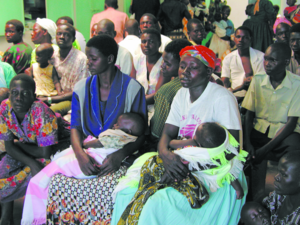

Health in Uganda refers to the health of the population of Uganda. The average life expectancy at birth of Uganda has increased from 59.9 years in 2013 to 63.4 years in 2019.[1] This is lower than in any other country in the East African Community except Burundi.[1][2][3] As of 2017, females had a life expectancy higher than their male counterparts of 69.2 versus 62.3.[4] It is projected that by 2100, males in Uganda will have an expectancy of 74.5 and females 83.3.[5][6] Uganda's population has steadily increased from 36.56 million in 2016 to an estimate of 42.46 in 2021.[7] The fertility rate of Ugandan women slightly increased from an average of 6.89 babies per woman in the 1950s to about 7.12 in the 1970s before declining to an estimate 5.32 babies in 2019.[8] This figure is higher than most world regions including South East Asia, Middle East and North Africa, Europe and Central Asia and America.[8] The under-5-mortality-rate for Uganda has decreased from 191 deaths per 1000 live births in 1970 to 45.8 deaths per 1000 live births in 2019.[9]
The Human Rights Measurement Initiative found that Uganda is fulfilling 80.0% of what it should be fulfilling for the right to health based on its level of income.[10] Total health expenditure as a percentage of gross domestic product (GDP) was 7.2 percent in 2014.[11]
In 2018, an estimated 1.4 million people in Uganda were infected with HIV,[12] and the HIV prevalence rate in the country was 5.7 percent.[12] As of 2019, this number had increased to an estimate of 1.5 million people living with HIV.[13] Uganda has made substantial progress in control of the epidemic as 1.3 of the confirmed HIV infected population was aware of their serostatus and 1.2 million were already on treatment.[13]
- ^ a b "Life expectancy". Our World in Data. Retrieved 9 September 2021.
- ^ "WHO - Uganda". World Health Organization. Retrieved 17 March 2017.
- ^ The World Bank (2013). "Life expectancy at birth, total (years)". Washington, D. C.: The World Bank. Retrieved 16 October 2016.
- ^ Vollset, Stein Emil; Goren, Emily; Yuan, Chun-Wei; Cao, Jackie; Smith, Amanda E; Hsiao, Thomas; Bisignano, Catherine; Azhar, Gulrez S; Castro, Emma; Chalek, Julian; Dolgert, Andrew J (October 2020). "Fertility, mortality, migration, and population scenarios for 195 countries and territories from 2017 to 2100: a forecasting analysis for the Global Burden of Disease Study". The Lancet. 396 (10258): 1285–1306. doi:10.1016/s0140-6736(20)30677-2. ISSN 0140-6736. PMC 7561721. PMID 32679112.
- ^ "Uganda". Institute for Health Metrics and Evaluation. 9 September 2015. Retrieved 9 September 2021.
- ^ Vollset, Stein Emil; Goren, Emily; Yuan, Chun-Wei; Cao, Jackie; Smith, Amanda E; Hsiao, Thomas; Bisignano, Catherine; Azhar, Gulrez S; Castro, Emma; Chalek, Julian; Dolgert, Andrew J (October 2020). "Fertility, mortality, migration, and population scenarios for 195 countries and territories from 2017 to 2100: a forecasting analysis for the Global Burden of Disease Study". The Lancet. 396 (10258): 1285–1306. doi:10.1016/s0140-6736(20)30677-2. ISSN 0140-6736. PMC 7561721. PMID 32679112.
- ^ "Uganda - total population 2016-2026". Statista. Retrieved 11 September 2021.
- ^ a b "Gapminder Tools". www.gapminder.org. Retrieved 11 September 2021.
- ^ "Uganda Under-5 mortality rate, 1960-2020 - knoema.com". Knoema. Retrieved 11 September 2021.
- ^ "Uganda - Human Rights Tracker". rightstracker.org. Retrieved 1 May 2023.
- ^ The World Bank (2015). "Health expenditure, total (% of GDP)". Washington, D. C.: The World Bank. Retrieved 16 October 2016.
- ^ a b "UNAIDS Data 2019". UNAIDS. 2019. p. 66. Retrieved 6 March 2020.
- ^ a b "Uganda". www.unaids.org. Retrieved 15 September 2021.